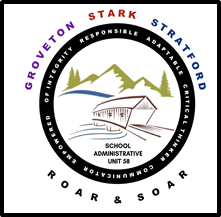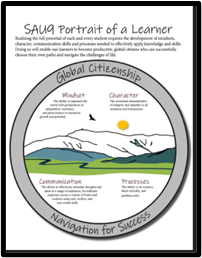Get support for student success - right in your inbox
NHLI | New Hampshire Learning Initiative
All Students Deserve a Quality Education
/ February 25, 2021
Portrait of a Learner: The District Catalyst for Deeper Relationships and Partnerships
The Portrait of a Learner is a collaborative process to define a vision for student success. This requires genuine input from district administrators, building administrators, teachers, students, families, community leaders, and business leaders. The vision, represented by an image, becomes the district’s North Star which guides school operations and pedagogy around a collective outcome for all students. With this vision, the community is taking a strong stance on what it means for their students to be college, career, and life ready. Identifying the essential or transportable skills to be successful after high school is part of this process. Communities are also reinforcing their commitment to supporting the whole child in a way that goes beyond test scores.
administrators, building administrators, teachers, students, families, community leaders, and business leaders. The vision, represented by an image, becomes the district’s North Star which guides school operations and pedagogy around a collective outcome for all students. With this vision, the community is taking a strong stance on what it means for their students to be college, career, and life ready. Identifying the essential or transportable skills to be successful after high school is part of this process. Communities are also reinforcing their commitment to supporting the whole child in a way that goes beyond test scores.
Why the change to Portrait of a Learner? Districts recognize that the competencies identified and valued by each community need to be developed over time and cannot just begin in high school, but rather need to be part of system thinking K-12. Portrait of a Learner is not just another name for the visioning exercise of a strategic planning process. The Portrait represents much more than an infographic that lives under the School Board tab on your School district website. It is a community vision that requires full transparency and partnership with the community from the time it is created until the time that student evidence is collected to prove it has become a reality for each and every graduate.
At the New Hampshire Learning Initiative, we believe that creating a community vision with the Portrait of a Learner, not only helps students prepare for college, career, and life, but also accomplishes the goals of SB276 and the Minimum Standards for Public School Approval.
In New Hampshire, a growing number of school districts have altered the national EdLeader21 process to better reflect local control context. The previous thinking was to recommend the creation of a small team, but we have learned that increased participation at all levels results in more buy-in and better outcomes. One NH district enlisted over 500 stakeholders to weigh-in on The Portrait including parents, students, teachers, and businesses. They used in-person focus groups as well as surveys to engage them. Another NH SAU has four different school boards and offered four different focus groups, with students leading the dialogue. And yet another, during the pandemic used surveys to not only determine community priorities, but also to choose an image that represented the district within the community. Three such images created by districts and their communities are included in this blog.
Deepening the Portrait of a Learner for districts, also involves connecting the dots within a district and aligning ongoing efforts in personalize learning and supporting competency-based education. Districts are doing great work in many areas and it is important to showcase how connected and integrated all these efforts are. This system thinking helps a district see the bigger picture for transforming teaching and learning in their district.
 While the process is different by community, what follows are the commonalities:
While the process is different by community, what follows are the commonalities:
- A clear purpose and reason why The Portrait is necessary.
- Proactive communication about the why and how to participate.
- Multiple ways for people to engage with the process.
- Continued involvement after the image is created.
- The image stays front and center, lives on the landing page of the website, and is referred to often.
- Follow up communication about the process, the outcomes, and what’s next.
- How to keep the participants involved after The Portrait is completed. For example, taking a pledge or joining a committee to help bring the portrait to practice.
- Stay true to the fact that it represents your district and community, therefore an ongoing partnership with the community is critical to achieve it.
At NHLI, we partner with districts and communities to help them articulate the following:
- What process works within the district’s context and is the most inclusive?
- Who needs to know about The Portrait?
- Where will The Portrait live so that it remains front and center?
- In what ways will the resulting competencies be the north star?
- Is the community ready to examine different types of data/evidence to ensure The Portrait becomes a reality?
Some school districts are thinking of re-imagining their Portrait of a Graduate. They recognize that if done well and with intention, The Portrait can bring clarity to decision making whether it be professional development or budget priorities. And it cannot be implemented inside the school walls. School districts know that while many of The Portrait competencies can be measured in the classroom, they won’t know if students are proficient, until they are able to apply them in real world contexts before graduating high school. That requires parents, businesses, and other community partners to weigh-in on how to assess that. At NHLI, we believe that The Portrait is optimized when all students have a Work-Based Learning experience to demonstrate their competency, whether that is an opportunity offered by the school, or recognizing experiences that students are having in their jobs.
Those school districts that have developed their Portraits with NHLI are now looking to use data with greater intention to implement best practices. They seek out different types of data/ information–such as peer to peer feedback for competencies such as empathy, confidence, and integrity–moving away from proficiency scales. They look at developing career pathways using career assessment data and NH Gallup Student Poll (It All Starts With Hope: NH Gallup Student Poll First in the Nation to Measure Work Based Learning (WBL) data which includes items about work-based learning to develop solutions with students.
New Hampshire is not alone in the effort to create strong north stars for what we care about and stand for in education. School districts are adapting national processes to ensure it makes sense in their local context and to their students NH communities recognize how rapidly our world is changing. Schools, communities, students, parents, and businesses are all saying, “nothing about us without us” and we know that requires relationship and partnership among them all.
adapting national processes to ensure it makes sense in their local context and to their students NH communities recognize how rapidly our world is changing. Schools, communities, students, parents, and businesses are all saying, “nothing about us without us” and we know that requires relationship and partnership among them all.
Interested in re-imaging or creating a Portrait of a Learner? Does your school district crave alignment to a community- created north star?
Join NHLI’s Future Learning Pathway Project, generously funded by the Barr Foundation. Contact ceastman@nhlearninginitiative.org to learn how to join the project.
Categories: NHLInsights, Research and Resources Portrait of a Learner
